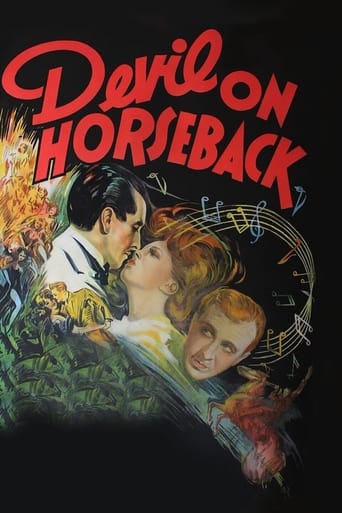MartinHafer
Apart from the novelty of seeing one of Errol Flynn's wives, Lila Damita, in this film, I can't really think of any conceivable reason to see "The Devil on Horseback". It's ample proof that even a big studio (in this case First National—a division of Warner Brothers) can make a really bad B-movie—one even worse than most tiny studio offerings.The film is set in Mexico. Fred Keating plays an annoyingly studio Mexican bandit—and plays him with all the subtlety of the Frito Bandito! He is truly a caricature of such a person and his simple-minded ways and style really are NOT a credit to the way Hollywood once treated minorities! A grinning idiot who LOVES to sing, that's Keating in this one. The guy is apparently in love with an American film actress (Damita) and insists on going into town to see her—even though he's been banished. The plot doesn't get any deeper than that and it's full of the sort of songs Jeanette MacDonald and Nelson Eddy sang—though much worse! So, you've got a dopey plot, lots of operatic singing, REALLY BAD acting, a racially insensitive portrait of our friends to the South and a plot that even a chimp could only do better! The bottom line is that this is a painful and boring film—one that, even if it IS in the public domain, isn't worth your time. Quite bad, I assure you.
FightingWesterner
A retired rebel breaks his government exile in order to meet a visiting Hollywood starlet. He's then talked into abducting her by her publicity-hungry manager (It doesn't take much convincing.) and brought to his hacienda. The charismatic rebel spends the next couple of days attempting to charm her, while competing with a coffee heir and contending with a jealous senorita.A mildly entertaining, lightweight romantic comedy, this has a few risqué moments (for 1936 anyway) and flirts around with the idea of one character possibly being a lesbian! There's also a a few interesting songs, that before long change into dance numbers as well, threatening to turn the film into a full-on musical.A frothy adventure, it would have benefited from some name stars.
loza-1
I have a poster for this film which touts it as in "full glorious colour". The copy I have is in black and white. There is the odd fragment missing, and some of the dialogue is a little out of synch. Otherwise, if this be the only copy around, there is no point in complaining.Diane (pronounced dee-ANN) Corday (Damita) is a Hollywood star visiting the fictitious Meso-American country of Alturas. Pancho (Del Campo) is a bandit who is a huge fan of hers - so huge that during kissing scenes involving Diane while watching the film, he will - Elvis style - take out a pistol and shoot at the screen. He and his muchachos surround a train carrying Diane. A journalist aboard thinks it would be good publicity for Diane if she were kidnapped by bandits. The kidnapping happens for real,and Damita and her entourage are taken to Pancho's hacienda. There is some singing and dancing before the principal characters pair off with the right people.My own opinion is that this is a B movie that was out of style in 1936 let alone now. The direction is patchy, and the production lacks the sheer professionalism of the big studios And, although there are some good performers in the cast, they struggle with a poor script. The train conductor's cap and Damita's vocal flourishes are one of the few things to raise a laugh in this so-called comedy. The settings are very claustrophobic. The only solo singer in the film (Del Campo) has a superb singing voice, and the music is quite good, as is the dancing. Del Campo and Damita get to cut a short but impressive caper.I'm not certain, but if my memory serves me correctly, there was a Spanish language version of this film, and I think practically the entire cast were changed for that, even though many of them - Damita certainly - could speak excellent Spanish. I am pretty sure that the film was set in a fictitious country to keep on the right side of the Mexican government who had (rightly in my opinion) complained that Mexicans in Hollywood films were nearly always portrayed as villains. The film features uniformed mounted police called "federals." ("Hey, Gringo! What is wrong with los federales?")This is more evidence of Mexican government appeasement.The film is perfectly watchable, even if it is almost certainly the second worst film featuring Damita. (Brewster's Millions must be the worst.)
paul meienberg
This film may no longer exist in the two-tone color process(Hirlicolor)as originally issued in 1936, however it does exist in black/white in 16mm format. The story line is curiously similar in parts to GAY DESPERADO filmed/released also in 1936. Ann Miller is fleetingly seen as a dancer. The film pushes the envelope with the portrayal of two gay characters: Jean Chatburn as Lily Damita's butch secretary and writer Tiffany Thayer perhaps just acting his natural sissy self. The movie progresses like a 'B" Western with a speedy plot resolution after a fairly enjoyable 72 minutes. Crane Wilbur's direction, story and screenplay all reflect his curiously bizarre and uneven talent.


